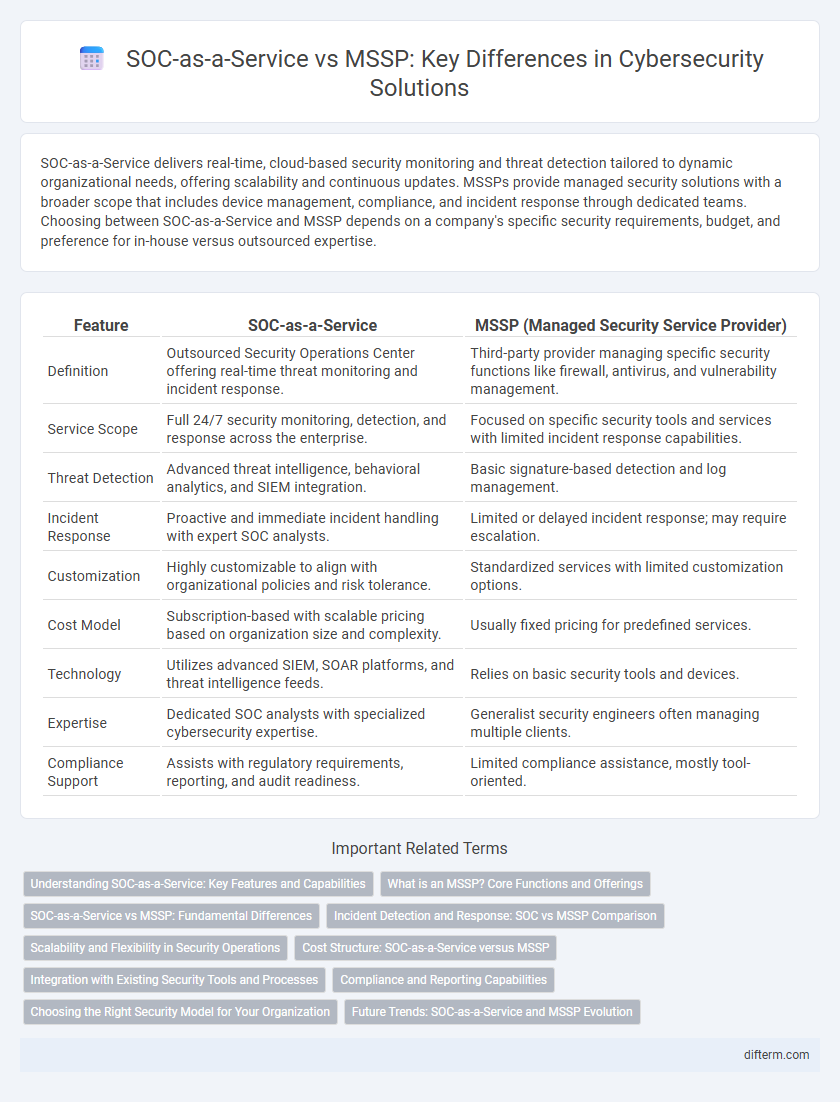SOC-as-a-Service delivers real-time, cloud-based security monitoring and threat detection tailored to dynamic organizational needs, offering scalability and continuous updates. MSSPs provide managed security solutions with a broader scope that includes device management, compliance, and incident response through dedicated teams. Choosing between SOC-as-a-Service and MSSP depends on a company's specific security requirements, budget, and preference for in-house versus outsourced expertise.
Table of Comparison
| Feature | SOC-as-a-Service | MSSP (Managed Security Service Provider) |
|---|---|---|
| Definition | Outsourced Security Operations Center offering real-time threat monitoring and incident response. | Third-party provider managing specific security functions like firewall, antivirus, and vulnerability management. |
| Service Scope | Full 24/7 security monitoring, detection, and response across the enterprise. | Focused on specific security tools and services with limited incident response capabilities. |
| Threat Detection | Advanced threat intelligence, behavioral analytics, and SIEM integration. | Basic signature-based detection and log management. |
| Incident Response | Proactive and immediate incident handling with expert SOC analysts. | Limited or delayed incident response; may require escalation. |
| Customization | Highly customizable to align with organizational policies and risk tolerance. | Standardized services with limited customization options. |
| Cost Model | Subscription-based with scalable pricing based on organization size and complexity. | Usually fixed pricing for predefined services. |
| Technology | Utilizes advanced SIEM, SOAR platforms, and threat intelligence feeds. | Relies on basic security tools and devices. |
| Expertise | Dedicated SOC analysts with specialized cybersecurity expertise. | Generalist security engineers often managing multiple clients. |
| Compliance Support | Assists with regulatory requirements, reporting, and audit readiness. | Limited compliance assistance, mostly tool-oriented. |
Understanding SOC-as-a-Service: Key Features and Capabilities
SOC-as-a-Service offers continuous, real-time threat monitoring and incident response through cloud-based platforms, enabling scalable and flexible security operations without the need for extensive on-premises infrastructure. Unlike traditional MSSPs, SOC-as-a-Service integrates advanced automation, AI-driven analytics, and customizable dashboards to provide proactive threat detection and rapid mitigation. Key capabilities include centralized log management, 24/7 security monitoring, and seamless collaboration with internal teams to enhance overall cybersecurity posture.
What is an MSSP? Core Functions and Offerings
A Managed Security Service Provider (MSSP) delivers outsourced monitoring and management of security devices and systems, emphasizing threat detection, incident response, and compliance management. Core functions include firewall management, intrusion detection, vulnerability assessment, and continuous security monitoring. MSSPs offer tailored security solutions to protect networks, endpoints, and cloud environments against cyber threats while ensuring regulatory adherence.
SOC-as-a-Service vs MSSP: Fundamental Differences
SOC-as-a-Service delivers real-time threat detection and incident response through a cloud-based security operations center, offering scalability and continuous monitoring without the need for on-premises infrastructure. MSSPs provide broader outsourced security management, including firewall management, vulnerability assessments, and compliance support, often with less emphasis on immediate incident response. The fundamental difference lies in SOC-as-a-Service's focus on proactive, centralized security operations versus MSSPs' comprehensive, but often reactive, outsourced security services.
Incident Detection and Response: SOC vs MSSP Comparison
SOC-as-a-Service offers real-time incident detection and response with continuous monitoring powered by advanced analytics and automation, enabling rapid threat identification and mitigation. MSSPs provide comprehensive security management, often combining incident response with broader IT services but may have slower detection times due to shared resources across multiple clients. Enterprises seeking proactive, scalable incident detection benefit from SOC-as-a-Service's dedicated threat intelligence and faster remediation capabilities compared to traditional MSSPs.
Scalability and Flexibility in Security Operations
SOC-as-a-Service offers enhanced scalability by providing on-demand security resources that adjust to fluctuating organizational needs without requiring significant capital investment. MSSPs often operate on fixed service tiers, limiting flexibility when rapidly adapting to evolving threat landscapes or operational shifts. Organizations seeking agile, scalable security operations favor SOC-as-a-Service for its cloud-native architecture and real-time scalability features.
Cost Structure: SOC-as-a-Service versus MSSP
SOC-as-a-Service offers a subscription-based pricing model that reduces upfront capital expenditures and operational costs by providing scalable security monitoring and incident response through cloud infrastructure. Managed Security Service Providers (MSSPs) often require longer-term contracts with fixed fees, potentially leading to higher overall expenses due to on-premises hardware and customized service integration. Businesses seeking flexible, cost-effective solutions typically benefit from SOC-as-a-Service's transparent, usage-based pricing compared to MSSP's traditional cost structure.
Integration with Existing Security Tools and Processes
SOC-as-a-Service platforms offer seamless integration with existing security tools and processes through advanced APIs and customizable workflows, ensuring real-time threat detection and response without disrupting operations. Unlike traditional MSSPs, SOC-as-a-Service provides continuous monitoring that adapts to evolving security environments by leveraging cloud-native architectures and machine learning analytics. This integration capability enhances overall security posture by enabling centralized visibility and orchestration across diverse technology stacks.
Compliance and Reporting Capabilities
SOC-as-a-Service offers real-time compliance monitoring and automated reporting aligned with industry standards such as HIPAA, GDPR, and PCI DSS, ensuring continuous regulatory adherence. MSSPs typically provide scheduled reports and periodic compliance assessments, which may delay issue detection compared to SOC-as-a-Service. Enhanced transparency and actionable insights from SOC-as-a-Service platforms streamline audit processes and reduce the risk of non-compliance penalties.
Choosing the Right Security Model for Your Organization
Selecting between SOC-as-a-Service and MSSP depends on your organization's security maturity and resource availability. SOC-as-a-Service offers continuous threat monitoring and advanced analytics with cloud-based flexibility, ideal for organizations seeking scalable, real-time incident response without heavy in-house investment. MSSPs provide comprehensive outsourced security management and compliance support, best suited for enterprises requiring broader security operations and tailored service level agreements.
Future Trends: SOC-as-a-Service and MSSP Evolution
SOC-as-a-Service is rapidly evolving with AI-driven automation and real-time threat intelligence integration, enhancing proactive threat detection and response capabilities. MSSPs are expanding their offerings by incorporating cloud-native security tools and advanced analytics to address increasingly complex, hybrid IT environments. Future trends indicate a convergence where SOC-as-a-Service models leverage MSSP expertise, delivering scalable, cost-effective, and adaptive cybersecurity solutions.
SOC-as-a-Service vs MSSP Infographic

 difterm.com
difterm.com